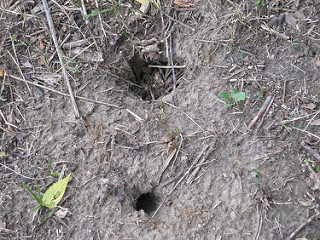Did an Animal Make Those Holes in My Yard?
By Chris Williams on September 10, 2015.
When he was mowing the lawn, my husband discovered several holes in the ground in our backyard. Do you think some kind of animal made those holes? Should we fill them in or put traps there or what?
T. W., Candia, NH

You don’t say how big the holes are, but when we find holes like that in a yard, the first thing our technicians do is determine whether they really were made by an animal, or are they manmade, or a result of erosion?
Is an Animal Responsible for the Hole?
When animals dig a hole, for whatever reason, they usually leave behind a fan of loose soil that was excavated from the hole (chipmunks and ground squirrels, however, remove the soil to help disguise their burrows). If there is no loose soil around the hole opening, it could be the result of subsidence, or soil collapse, for example around a rotted root. Sometimes lawn holes are the result of mole tunnels below collapsing in several places as a result of heavy rains (see Mole Tunnels Everywhere!). If there’s soil around the opening, it was likely made by an animal, but not necessarily a mammal. There are other creatures that will leave a good-sized ground hole that can be confused with a small mammal burrow such as crayfish, ground-nesting yellowjackets, cicadas, and cicada killer wasps.
Is the Hole an Animal’s Burrow?
If the holes were made by an animal, they could be either nest burrows or exploratory holes used to find food. For example, skunks like to feed on grubs and other soil insects and they forage at night. They will leave behind lots of exploratory holes as they root for their dinner. It’s not unusual for a homeowner to step outside in the morning and find dozens of holes in their lawn that weren’t there the day before, thanks to a visiting skunk (see Skunks’ Digging Can Damage Lawns). Besides skunks, other animals such as squirrels, raccoons, and armadillos will also dig holes while looking for insects or nuts. These foraging holes may look like burrow openings but if you probe into the hole, it may end a few inches in. Be aware though that some animal burrows make a sharp right turn after a few inches and continue on. Are the holes in the middle of the yard? If so, they are more likely to be foraging holes. Burrowing animals most often locate their burrows along edges, in sheltered places or heavy vegetation, or even under porch slabs or foundations… rather than out in the open. Are the holes mounded? Moles construct conical mounds of dirt around the openings of their burrows. The soil around the opening of an occupied, well-used burrow will eventually become hard-packed and will be free of leaves and debris.
Give Our Nuisance Wildlife Specialists a Call
If the holes don’t have any depth and seem to be foraging holes, you can fill them in. Talk to us about trapping the animal responsible, though; don’t try to do that yourself because there are legalities involved. But if you can’t tell whether or not the holes are burrows, or if you suspect a mole burrowing in your yard, give Colonial Pest a call. Our nuisance wildlife specialists will be able to tell whether the holes are burrows and can usually tell who made them. These guys are also trained and certified to trap wildlife that has moved into residential yards.